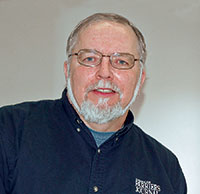One of the things I notice at hoof-care clinics is how different people have different ways of getting the most out of them.
Jeff Pauley, a farrier from North Carolina and himself a clinician for Delta-Mustad Hoofcare Center, once told me when he’s at a clinic, he likes to ask a clinician to share his or her “train wrecks.” Pauley says his own experience has taught him there is often as much to be learned from cases that went wrong as there is from those that went right.
Awesome Asides
In my editor’s role, I enjoy collecing “side tips” from clinicians that aren’t included in the Power Point slides and are often only on the periphery of the subject matter.
In marketing terms, I think of them as an added value. If the clinician were to write a story on a particular topic, these asides would probably be left out. You have to be there to benefit from them. It expands the experience — sort of like hearing a great musician play live as opposed to hearing a studio recording.
During October, I took in the annual fall clinic at Centaur Forge in Burlington, Wis. The clinician was Michael Wildenstein, a member of the International Horseshoeing Hall Of Fame, who is also a clinician for Farrier Product Distribution.
I’ve heard the New York farrier speak and watched him do demonstrations on numerous occasions. I’ve even heard him speak on exactly the same topics he covered at Centaur Forge. But there’s always something new.
Thrush Isn’t A Minor Issue
Dealing with thrush wasn’t on his topic list, but in a short aside, he offered some advice that might help you convince horse owners that they should be serious about treating thrush and not simply expecting you to take care of it every 6 or 8 weeks.
“Thrush defoliates the tip of the frog, destroying protection and shock-absorbing qualities of the frog,” Wildenstein told those in attendance. “In the central sulcus, thrush affects the integrity of the hoof.”
That, says Wildenstein, means thrush is “very much” a farrier issue.
“Thrush is often a heel issue,” he says. “The horse may try to protect it, shift its weight and change its stance. All of that can affect hoof growth. The horse is not going to move as well as it would if it had a healthy frog. It’s going to have a lot more sensitivity.”
Get Involved
The late George Platt, a member of the International Equine Veterinarian Hall Of Fame, frequently took part in clinics and hammer-ins designed to teach farriers how to properly build and apply heart bar shoes. Along with the late Texas farrier Burney Chapman, Platt was instrumental in the reintroduction of the heart bar.
One of Platt’s pet peeves involved those who attended hammer-ins — but opted out of the actual hammering.
“We have too many guys standing around and watching the other guys work and not enough getting into the fire themselves,” Platt told a group of Montana State University horseshoeing students back in 2006. “You’re not going to learn to put them on properly by just watching someone else.”
Find Your Own Way
During the recent clinic at Centaur Forge, there were plenty of farriers who took advantage of Wildenstein’s trimming and shoeing demonstration to get up close and ask questions — some even picking up the hooves and checking out the work. Others preferred to listen closely, take notes, or shoot photos or video — often using smart phones.
It’s important in any kind of learning to find methods that work best for you. The one thing we all should avoid is passing up these excellent opportunities to expand our knowledge.
In the comments section below, please share the methods and techniques that help you get the most out of hoof-care clinics. And add any of the valuable “asides” you’ve picked up recently.








Post a comment
Report Abusive Comment